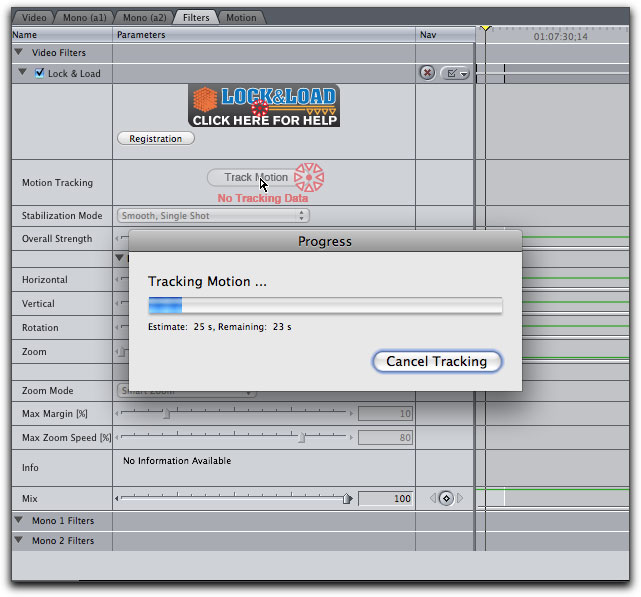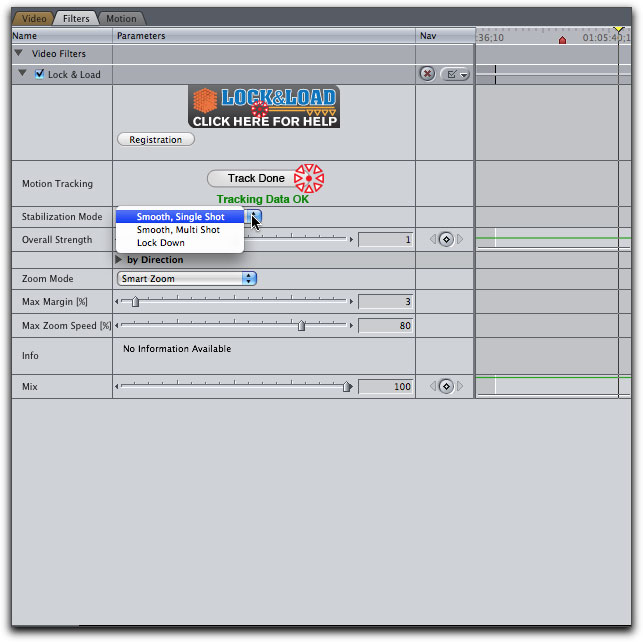
September 7, 2009
CoreMelt's 'Lock & Load' Stabilizing Plug-in
for Final Cut Pro and Motion

CoreMelt $149.00
$99.00 for owners of CoreMelt Complete V2
Review by Steve Douglas
One thing that has consistently impressed me whenever I have reviewed any products from CoreMelt is that they never appear to stop working on improvements to their plug- in sets even long after they have been released. Editors have continually been notified of both new products and updated and improved plug-ins, usually with several new or free plug-ins included.
Brand new on the shelf is a CoreMelt's Lock & Load stabilizer plug-in for both Final Cut Pro and Motion, completely compatible with the new FC Studio 3, as well as former versions. Required is a G5 or Intel processor running Mac OS X 10.5.4 (or later), and Final Cut Studio 2 (FCP6.0.2 or later), Motion 3.0.2 (or later) or Final Cut Express 4.0 (or later).
While there are some similarities between Lock & Load and Final Cut Pro's 'Smooth Cam' or Magic Bullet's 'Steady' in that they all work on the basis of scaling up after analysis, it is the differences between these choices that really make CoreMelt's Lock and Load stand ahead of the pack.
Once installed, as you would any filter, Lock and Load is found in its own C2 Lock & Load bin in the Effects/Filters and is placed upon the clip as you would any filter. Lock and Load will only analyze between the in and out points so you won't have to worry about wasting hard drive space on unused media or, as with Apple's Smooth Cam, need to export your in and out points as a self contained movie before importing back into Final Cut Pro and applying the Smooth Cam filter in order to best avoid the larger analyzed files. There is little learning curve with Lock & Load as it is a simple an intuitive matter of clicking on the Track Motion button, which then analyzes your clip at a very impressive pace.

The entire process is as simple as can be.
Apply the Lock & Load filter to your clip in the timeline and click on the Track Motion button in your filter's tab.
All analyzed files are stored in the Hard Drive Users Home directory/ Library/Application Support/CoreMelt /Lock & Load and for the 5 -13 second clips I tested Lock & Load with, the files sizes ranged from only 32-88kb. Pretty small.
The analysis blazed, especially compared to both Apple's Smooth Cam and Magic Bullet Steady. CoreMelt claims a 6x increase in analysis speed over Smoothcam and literally double the speed of Magic Bullet Steady. A 4.28 second clip completed its motion tracking analysis in 22 seconds and a 13.03 sec clip took just 59 seconds which was almost spot on to what the motion tracker's estimate bar predicted. Rendering for both clips was quite quick with a render time of 46 seconds for the 4.28 sec clip and 57 seconds for the 13.03-second clip. Compare 'Smooth Cam' to CoreMelt's 'Lock & Load' and it will seem as if Smooth Cam is standing still.
Once you have finished the quick task of allowing Track Motion to do its thing, you have a few choices as to how you wish to fine-tune the results.
There are 3 modes of Stabilization. I tested using the one most editors, I believe, will go to more frequently, the Smooth Single Shot mode which will smooth out the jitter and bumps maintaining your basic camera motion. The Smooth, Multi shot mode selection can detect cuts in footage and treat them separately. I tried this mode on a clip with a cut in it and the Smooth, Multi shot mode did a good job. I did notice that the percentage of the actual zoom seemed about the same for both parts of the clip when I expected the second cut to have considerably less zoom to it. Perhaps I was simply mistaken in my expectation. When next applied to a clip with 2 cuts in it, there was a change of zoom from 102% to 106% between the three sections of the clip which shows that Lock & Load really does detect the cuts and adjusts for the changes present. The final mode, Lock Down' has its uses as well, I would imagine a jitter or bump while using a tripod or monopod would take advantage of the Lock Down mode. However, it appeared that the amount of zoom using Lock Down was considerably greater than in the other modes. For my nature genre footage the zoom percentage jumped to huge amounts rendering Lock Down mode inappropriate for the type of footage I generally film.

While the Smooth, Single Shot mode will be the most used method to achieve stabilization, the other modes work well and have their purposes.
Smart Zoom is, additionally, the zoom mode that will be most preferred.
There are also 2 Zoom modes. The Smart Zoom is the way to go for most situations and for the majority of editors using Lock & Load. However, when I switched to the Fixed Zoom mode, I found it very easy to keyframe the amount of zoom to my footage needs.
Finally, once you have established the mode of both stabilization and zoom you have the Maximum Margin control which defaults to 10. The greater the margin setting the better it is in regards to retaining the maximum video resolution. For my underwater clips where fighting currents and surge is always a problem, I needed to set the margin percentage to 2 or 3. For topside handheld shots a margin percentage of 8/9 usually did the trick. Before rendering, you can play your clip in the timeline and see in the Lock & Load info box the amount of zoom applied as it changes over the course of the clip. Once rendered, you no longer have access to this information. I would prefer that I could still see this info even after render.

You can see the margins on the left of this clip of a marble ray after the Track Motion analysis has been applied. The next step is to adjust the strength and zoom.

The same clip with the maximum margin set to 3% which resulted in a 104% zoom and very little loss of resolution.
Keep in mind; using any form of stabilization filter, that I am aware of, requires a compromise between stability and video resolution. The more you zoom in to repair a less than stable shot, the greater the decrease in resolution. There is really no need to use a stabilizer on a clip devoid of unwanted movement and shot solidly off a good tripod. However, there are many times where tripod pans and tilts as well as hand held shot jitter demand an excellent motion tracker and stabilization.
For those who have not already purchased CoreMelt's V2 Complete, the Lock & Load Stabilizing filter, now included, will provide added incentive to acquire an already excellent and useful set of transitions, filters and generators. For those who smartly purchased the V2 complete package, Lock & Load comes at minimal cost.
CoreMelt does provide a free 15 day trial demo of Lock & Load downloadable from their website as well as an excellent 'getting started' video demonstrating just how easy Lock & Load is to use and apply. The supplied PDF manual is concise but complete and answered any initial questions I had regarding supplied parameter controls. With the ability to use all types of footage, compensate for rotational changes in both the x and y axis and intelligently ignore foreground movement, I found CoreMelt's 'Lock & Load' to be my new 'go to' when stabilization is needed. Bottom line here is that CoreMelt's Lock & Load was incredibly easy to use and as intuitive as you can get. Very well worth the purchase!
 Steve Douglas is a certified Apple Pro for Final Cut Pro 6 and underwater videographer. A winner of the 1999 Pacific Coast Underwater Film Competition, 2003 IVIE competition, 2004 Los Angeles Underwater Photographic competition, and the prestigious 2005 International Beneath the Sea Film Competition, where he also won the Stan Waterman Award for Excellence in Underwater Videography and 'Diver of the Year', Steve was a safety diver on the feature film "The Deep Blue Sea", contributed footage to the Seaworld Park's Atlantis production, and productions for National Geographic and the History channels. Steve is also feature writer for Asian Diver Magazine and is one of the founding organizers of the San Diego UnderSea Film Exhibition. He is available for both private and group seminars for Final Cut Pro and leads underwater filming expeditions and African safaris with upcoming excursions to the Red Sea and Egypt for Nov.2009, Feel free to contact him if you are interested in joining Steve on any of these exciting trips. www.worldfilmsandtravel.com
Steve Douglas is a certified Apple Pro for Final Cut Pro 6 and underwater videographer. A winner of the 1999 Pacific Coast Underwater Film Competition, 2003 IVIE competition, 2004 Los Angeles Underwater Photographic competition, and the prestigious 2005 International Beneath the Sea Film Competition, where he also won the Stan Waterman Award for Excellence in Underwater Videography and 'Diver of the Year', Steve was a safety diver on the feature film "The Deep Blue Sea", contributed footage to the Seaworld Park's Atlantis production, and productions for National Geographic and the History channels. Steve is also feature writer for Asian Diver Magazine and is one of the founding organizers of the San Diego UnderSea Film Exhibition. He is available for both private and group seminars for Final Cut Pro and leads underwater filming expeditions and African safaris with upcoming excursions to the Red Sea and Egypt for Nov.2009, Feel free to contact him if you are interested in joining Steve on any of these exciting trips. www.worldfilmsandtravel.com
copyright © Steve Douglas 2009
are either registered trademarks or trademarks of Apple. Other company and product names may be trademarks of their respective owners.
All screen captures, images, and textual references are the property and trademark of their creators/owners/publishers.